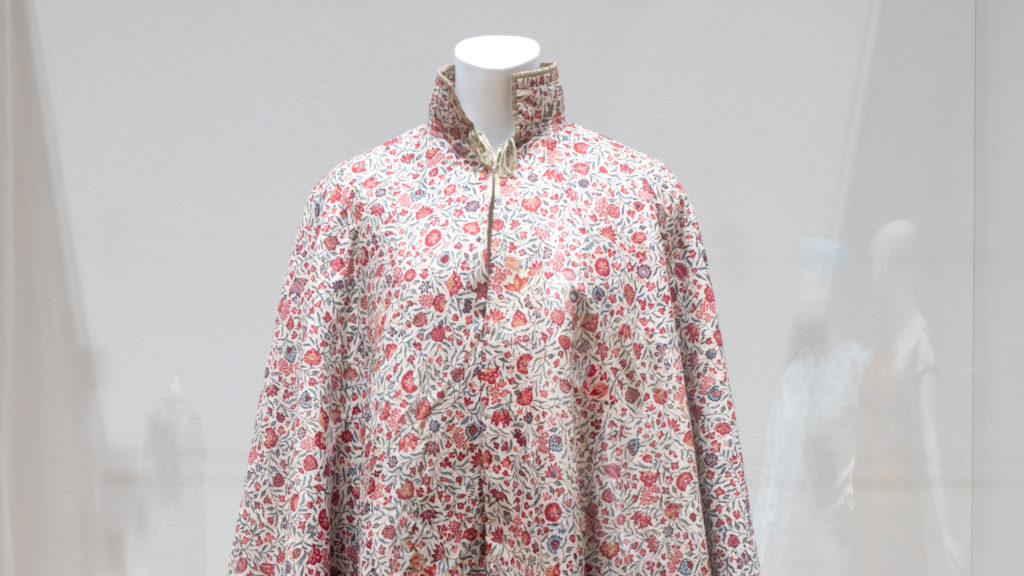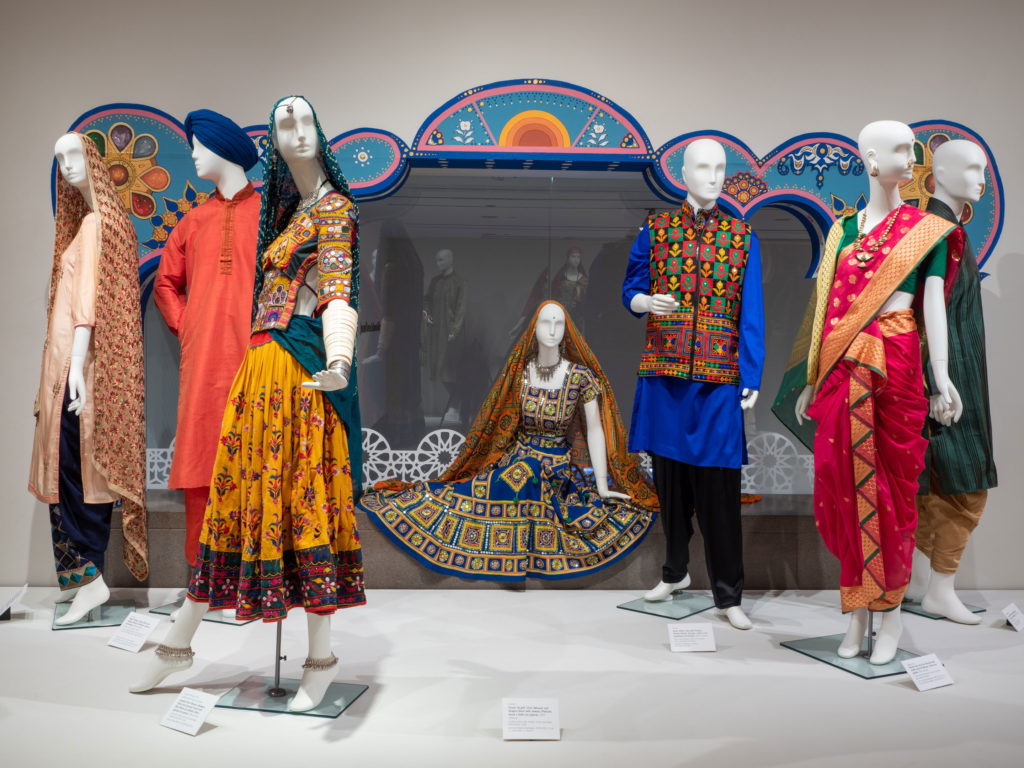India: Fashion’s Muse is organized by Phoenix Art Museum. It is made possible through the generosity of Arizona Costume Institute, The Virginia M. Ullman Foundation, Jacquie and Bennett Dorrance, Ellman Foundation, Ellen and Howard C. Katz, Opatrny Family Foundation, Janet and Chip Glaser, Meredith and Charles von Arentschildt, and Men’s Arts Council. It is also made possible through the generosity of the Museum’s Circles of Support and Museum Members.
For more than 5,000 years, India’s weavers have produced some of the finest textiles in the world. Considered the region’s national treasure, this wealth of cloth informs an array of dress traditions that mirrors India’s rich cultural diversity.
The exhibition celebrates the extraordinary craftsmanship of clothing from India as well as the couture fantasies they have inspired. Stunning ensembles and accessories highlight both the complicated history of colonialism as well as India’s long influence on global fashion.
The colors, imagery, and silhouettes distinctive to the region reverberate in designs by Chanel, Givenchy, Christian Dior, and Alexander McQueen. Western interpretations of the paisley symbol and of traditional garments such as the sari and the turban illustrate centuries of fascination with these unique styles.
The exhibition culminates with a selection of garments from contemporary Indian fashion designers, including couture work from Anamika Khanna’s Fall 2019 collection. These exquisite works strike a balance between the old world and the new, allowing new conversations to emerge.
Home to more than 1.3 billion people today, India is a geographically, culturally, and religiously diverse society with thousands of years of rich, complex history. Mirroring this mosaic of culture are dozens of unique dress traditions that are specific to each region. This gallery explores examples from just nine of India’s 28 states, revealing distinct differences and subtle similarities. Through color, drape, texture, and imagery, the wearer offers clues to their identity, including details such as homeland, marital status, social ranking, and wealth. Western designers have drawn inspiration from the regional dress of India to create such commonly known garments as the pajama set and the MC Hammer pant.
The sari (pronounced “sahr-ee”) is a complex garment composed of a single length of fabric. Also spelled “saree” in English, the Sanskrit term means “strip of cloth,” and yet the design is conceived on the loom as a three-dimensional garment. Mathematically precise distribution of thread combinations and densities of pattern add weight to specific portions, providing drape and strength and yielding a range of beautiful silhouettes. Made from yards of cloth measuring between five- and nine-yards long, the sari is an entirely unstitched garment that relies on a series of pleating, tucking, and tying to stabilize the look. Across India, women wrap saris in hundreds of different ways, reflecting the traditions of their region and the sari's centuries-old history. The design’s versatility allows the wearer to create a variety of looks that even include long pants as well as swimming shorts. Western fashion designers have reduced the sari from nine yards of cloth to tailored pattern pieces, effectively eliminating the culturally significant draping. They focus instead on its most iconic element, an asymmetric sash hung from the shoulder.
Although this popular motif originated in the East, it has become a worldwide fashion staple named for a town in Scotland. The intricate, teardrop shape developed from the Persian “boteh” and is believed to be based on a bent cypress tree symbolizing fertility and prosperity. Adaptations appeared across India by the 16th century with variations in form and name that reflect the diversity of each region. By the early 1800s, Western fashion designers had become obsessed with Kashmir shawls, a fine accessory featuring stylized versions of the paisley image that are woven from the soft, wintery undercoat of the Pashmina goat. These luxurious and intricate textiles could take a skilled weaver years to produce by hand and were prized gifts from Mughal emperors and Imperial maharajas. By 1820, the town of Paisley, Scotland became the leading producer of imitation Kashmir shawls for Western markets. The new Jacquard loom could weave the complex patterns at high speed, using a punch card system reminiscent of early modern computers. These affordable copies flooded the market and drove down demand for the Indian original among Western consumers. The paisley has been a global fashion trend ever since.
CHINTZ

Chintz is a glazed cotton fabric that is printed by hand using a carved wooden block and painted with a complex floral pattern. Introduced to Western Europe in the 17th century, chintz was highly favored for its beauty, strength and durability. Demand for chintz and other Indian textiles surged in Western markets throughout the 17th and 18th centuries, led by the efforts of the Dutch and British East India Companies. Through a series of campaigns aimed at deliberately disabling the Indian textile industry these colonialists attempted to appropriate chintz and other textiles. The quality and artistry of true Indian chintz however has outlived western interpretations and remains one of the most commonly reproduced patterns worldwide.
Turbans have been worn across India for centuries, resulting in many different expressions and traditions associated with this highly practical garment. From a symbol of social rank to a demonstration of religious devotion, turbans hold a supremely important place in Indian culture. Although mostly worn by men, turbans have also been adopted by women, a practice seen as advancing equality. Today, turbans are less common but still worn daily for religious and customary practices as well as part of wedding attire. Western fashion’s trendsetters have been drawn to the turban since the Middle Ages, co-opting it to fit each new time period’s zeitgeist. As a conspicuous example of cultural appropriation, high-fashion’s imitation turbans are chiefly designed to create a dramatic silhouette.
The focal points of this dress are the two appliquéd lace peacocks, which are native to India and symbolic of war and royalty. This was originally part of McQueen's Fall/Winter 2008-9 collection, which was titled "The Girl Who Lived in a Tree," and was conceptualized after McQueen had taken an extended trip to India. Image credit: Alexander McQueen, Peacock Dress, Fall/Winter 2008-2009 (detail). Courtesy of the FIDM Museum at the Fashion Institute of Design & Merchandising, Los Angeles. Commissioned 2010: Funds donated by Karen Coombs-Jordan.
Animals native to India such as the peacock, the tiger, and the elephant are often the subject of fashion's fantasies. From hand-beaded animal prints on silk chiffon, to romanticized hunting scenes printed on silk charmeuse, and even sculptural purses glittering with rhinestones, designers interpret these images to suit their individual aesthetic. Capturing the interest of Worth Leiber, Hermès, and beyond, high fashion has paid homage to India in a variety of elegant and clever ways.
This style of jacket, named for India's first Prime Minister Jawahalal Nehru, perfectly suited the slim fit and sharp silhouettes popular during the mid-1960s. Two popular movements at the time, the Mod movement and the Peacock Revolution, both readily adopted this style of collar and reproduced it in versions from classic black to psychedelic color blends. Seen on jackets, leisure suits, dress shirts, and even women's wear, the Nehru collar was and has remained a strong global trend.
Anamika Khanna blends the traditional techniques of India with modern tailored silhouettes to suit the global woman. Each couture garment began with a solid color fabric. The additional colors are composed of exquisite layers of hand-worked thread embroidery, glass beading, and metallic embroidery. From the heavily encrusted zardosi work (burnished metal-wrapped thread that requires between 6,000-8,000 hours of labor per skirt) to the handmade fringed tassels, the resulting ensembles are a stunning catalogue of numerous regional techniques.
ABOUT THE EXHIBITION
EXHIBITIONS
On view for a limited time, exhibitions present art from across the centuries and the globe, from iconic fashion to Old Master paintings, contemporary photography to historical objects of Asia.
MORECOLLECTIONS
Featuring more than 20,000 objects, the collection spans the globe, bringing the world to our city, and our city to the world.
MORE